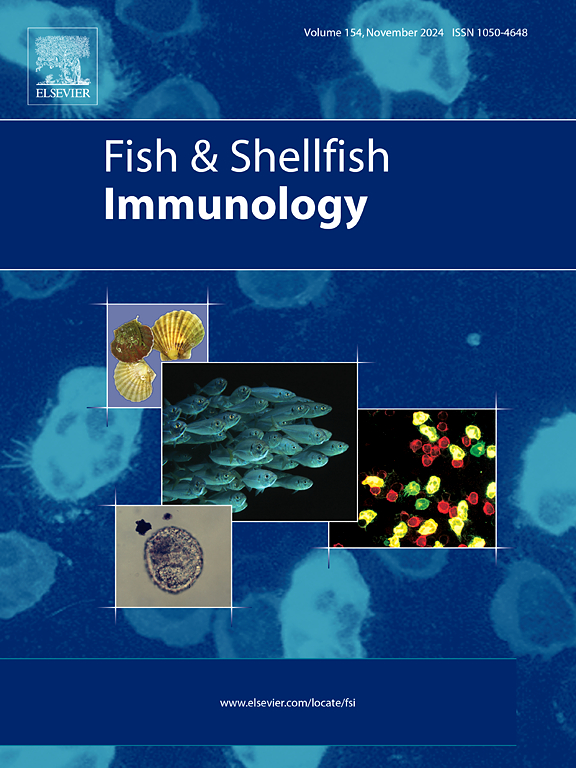Astragaloside IV can mitigate heat stress-induced tissue damage through modulation of the Keap1-Nrf2 signaling pathway in grass carp (Ctenopharyngodon idella)
IF 4.1
2区 农林科学
Q1 FISHERIES
引用次数: 0
Abstract
This study investigated the potential protective effect of AS-IV against heat stress-induced tissue damage in grass carp (Ctenopharyngodon idella). Grass carp were injected intraperitoneally with 0, 2, 4, and 8 mg/kg of AS-IV for three consecutive days, and then subjected to heat stress (35 ± 0.5 °C); thereafter, histopathological analyses of the liver and spleen were performed at 0, 6, 24, and 48 h, respectively. The results indicated that sustained heat stress resulted in hemorrhage, vacuolization, increased hepatic blood sinusoidal space, inflammatory cell infiltration in the liver, and decreased number of melanomacrophage centers in the spleen; conversely, 4 and 8 mg/kg AS-IV attenuated the pathological symptoms induced by heat stress and mitigated tissue damage in the liver and spleen of grass carp. The possible mechanism is that AS-IV promotes Nrf2 signaling through the downregulation of keap1a and keap1b, thereby activating the Keap1–Nrf2 signaling pathway, leading to changes in the levels of protection-related genes in the liver (GSH-Px and CAT levels were elevated while MDA levels were decreased, and gsh-px, cat, cu-zn sod, and hsp70 mRNA levels were upregulated while il-6 mRNA levels were downregulated) and spleen (GSH-Px, CAT, SOD, and GSH levels were increased while MDA levels were decreased, and il-6 mRNA levels were downregulated), which, in turn, improves the antioxidant ability of grass carp. Additionally, an appropriate dose of AS-IV transiently increased complement C3 levels after sustained heat stress, thereby improving the immunity of grass carp under heat stress. In conclusion, AS-IV can mitigate tissue damage induced in response to heat stress by modulating the redox homeostasis of grass carp and can be practically implemented in aquaculture sector.
黄芪甲苷可通过调节草鱼Keap1-Nrf2信号通路减轻热应激诱导的草鱼组织损伤。
本研究探讨了AS-IV对草鱼热应激诱导的组织损伤的潜在保护作用。草鱼连续3天腹腔注射0、2、4和8 mg/kg AS-IV,然后进行热应激(35±0.5℃);之后,分别于0、6、24和48 h对肝脏和脾脏进行组织病理学分析。结果表明,持续热应激导致大鼠出血、空泡化、肝血窦间隙增大、肝脏炎症细胞浸润、脾脏巨噬细胞中心数量减少;相反,4和8 mg/kg AS-IV可减轻草鱼热应激引起的病理症状,减轻肝、脾组织损伤。可能的机制是AS-IV通过下调keap1a和keap1b来促进Nrf2信号通路,从而激活Keap1-Nrf2信号通路,导致肝脏(GSH-Px和CAT水平升高而MDA水平降低,GSH-Px、CAT、cu-zn sod和hsp70 mRNA水平上调而il-6 mRNA水平下调)和脾脏(GSH-Px、CAT、sod、提高和GSH水平,降低MDA水平,下调il-6 mRNA水平),从而提高草鱼的抗氧化能力。此外,适当剂量的AS-IV可在持续热应激后短暂增加补体C3水平,从而提高草鱼在热应激下的免疫力。综上所述,AS-IV可通过调节草鱼氧化还原稳态来减轻热应激对草鱼组织的损伤,可在养殖业中实际应用。
本文章由计算机程序翻译,如有差异,请以英文原文为准。
求助全文
约1分钟内获得全文
求助全文
来源期刊

Fish & shellfish immunology
农林科学-海洋与淡水生物学
CiteScore
7.50
自引率
19.10%
发文量
750
审稿时长
68 days
期刊介绍:
Fish and Shellfish Immunology rapidly publishes high-quality, peer-refereed contributions in the expanding fields of fish and shellfish immunology. It presents studies on the basic mechanisms of both the specific and non-specific defense systems, the cells, tissues, and humoral factors involved, their dependence on environmental and intrinsic factors, response to pathogens, response to vaccination, and applied studies on the development of specific vaccines for use in the aquaculture industry.
 求助内容:
求助内容: 应助结果提醒方式:
应助结果提醒方式:


